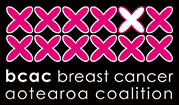Breast Cancer Aotearoa Coalition committee member, Julie Graham, attended the recent Breast cancer Network Australia Strength to Strength National Conference.
More than 600 women from around Australia and the world attended the conference in Sydney which brought together health professionals, researchers and women with breast cancer to listen, learn and debate the key issues in breast cancer treatment and care.
Julie says the conference was a fantastic experience and she learnt a lot about breast cancer and how to deal with the challenges it throws up.
You can read Julie’s notes on each guest speaker’s presentation below or download this PDF for the Breast Cancer Network Australia's summary of each of the speaker's talk.
Breast cancer – why me?
Presented by: Professor Dame Valerie Beral – Professor of Epidemiology, Cancer Epidemiology Unit, Oxford University
High rates of breast cancer in all Western countries, with a rapid increase predicted in urban China and Japan from 1,400,000 in 2008 to 2,000,000 in 2030.
A decrease in breast cancer in high income countries has been linked to a drop in the use of Hormone Replacement Therapy (HRT) and death rates have been falling rapidly since 1990 largely due to improvements in treatment and early detection (including screening).
A Collaborative Group has been looking at Hormonal factors in breast cancer taken from data on 200,000 women with breast cancer and the findings are as follows:
·
- Oral contraceptives - an increased risk while taking these but the risk goes away over time, 8-10 years
- HRT - an increased risk but decreases rapidly when stopped and risk gone @ 4 years.·
- Menopause – hormone levels drop rapidly @ menopause, the risk is 50% higher pre menopause when estrogen level is high as to post menopause. Obese women have higher hormone levels than thinner women therefore they are at an increased risk.
- Child bearing - number of births (the risk drops 10% per child), age at first birth (the older a women is there is increased risk), breast feeding length (longer the better), age of menarche (earlier increases the risk)
- Overweight women are more at risk
- Alcohol consumption increases risk
Tamoxifen – for Estrogen Receptor Postive (ER+) breast cancer. Tamoxifen halves the death rate (or doubles survival rate) and also reduces the incidence of cancer in the other breast. The benefit of five years of Tamoxifen lasts over 15 years but recent trials indicate that taking Tamoxifen for 10 years would be more beneficial (results of these trials are to be released at the San Antonio Conference).
Aromatose Inhibitors (AI) – these work in post menopausal women and are slightly better than Tamoxifen. Recurrence rate with Tamoxifen 15.3% and AI 11.8%
Hysterectomy – improves survival @ roughly the same rate as Tamoxifen so could be used in cases of low tolerance of Tamoxifen or AI’s.
Hormones associated with reproduction are key for the causation, prevention and treatment of breast cancer.
The main things a women can do to reduce her chance of getting breast cancer are to avoid hormone therapies, keep weight down and minimise alcohol intake.
To improve chance of surviving breast cancer – use some type of hormone blocking therapy (eg Tamoxifen) for five years or longer (ER+ cancers). DON’T STOP TAKING THIS – look at options if problems occur.
If there was some way to mimic pregnancy in women via a hormone treatment this could provide lifelong protection against breast cancer.
Personalised Treatment – are we there yet?
Presented by Associate Professor Fran Boyle – Medical Oncologist (BREAST CANCER Oncologist for 20+ years)
Fran had some great analogies for the different types of breast cancer – a great way to understand for the lay person!!
- Triple Negative – like a screaming baby going @ both ends! (least mature, fast growing)
- HER2 + - like a feral teenager!
- ER+ Speedy – older more mature but a bit feral @ times!
- ER+ Slow – like an elderly person (most mature, slow growing)
Ways to Personalise Treatment:
- Personalising to age and life stage
- Personalising to location – distance to treatment centre dictates choice of surgery, access to radiation, choice of reconstruction, scheduling of chemotherapy. Research taking place into easier methods of drug delivery, e.g. sub-cutaneous Herceptin. Evaluation of shorter radiotherapy courses.
- Personalising – How you are travelling? – include other health problems and meds, pregnancy, fertility concerns, familial cancer, psychosocial / mental health issues, culture and language
- Personalising Hormone Therapy
Personalising HER2 directed therapy
How long to take Herceptin? 1 year v 2 years, definitely 1 year better (HERA trial). Is it better to block HER2 with two drugs? Combinations of Herceptin with Lapatinib (Tykerb) or Pertuzumab (Perjeta) – in trial.
Can one avoid chemo side effects? Linked Herceptin to chemo delivered only to the cancer cell (T-DMI Kadcyla)
Personalising Triple Negative BREAST CANCER
Testing for BRCA mutations – better response to DNA damaging chemo, potential role for PARP inhibitors which block DNA repair.
Other Chemotherapy – plantinum based or maintenance oral chemo.
Personalising – Hair matters
Currently research underway on scalp cooling to reduce hair loss. The cooling starts before chemo and continues during then for a couple of hours after chemo has finished.
Personalising Secondary breast cancer treatment – Rebiopsy?
Rebiopsy can change plans for treatment as the original treatment may have altered the make-up of the cancer.
Bone Health
Presented by Dr Richard de Boer – Medical Oncologist
Optimising bone health is a critical part of breast cancer care. Bone loss can be caused by aging, natural menopause and various cancer treatments. Causes of accelerated bone loss are chemotherapy, Aromatose Inhibitors and Ovarian Suppressants.
Bone metastases are the first site of relapse for 40-50 per cent of women with breast cancer. Treatment options: pain relief is important, systemic anti-cancer treatment, surgery, radiotherapy, Osteoclast inhibition.
Conclusion: It is important for breast cancer patients to have a DEXA scan (bone density scan) @ least once during their breast cancer treatment. Vitamin D levels in patients should be tested and replaced appropriately – the optimum level is ≥75 and optimising bone health and preventing osteoporotic fractures and skeletal related events is critical.
Exercise
Presented by Dr Sandi Hayes – Exercise Physiologist and Senior Research Fellow at the Institute of Health and Biomedical Innovation, QUT
Exercise influences every single physiological system in the body – heart and lungs, muscles and bones, immune system, weight and body composition, mental health, fitness and function.
During treatment it is recommended that women continue to exercise at an appropriate level and build slowly.
Lymphoedema – exercise does not cause or exacerbate Lymphoedema and it may reduce some incidences.
Weight – exercise stops or prevents weight gain, helps weight loss.
There have been over 70 randomised control trials which indicate that exercise influences survival after breast cancer and reduces the risk of death by 34%, this is based on 180 minutes of exercise / week.
Exercise Goal: work towards and build slowly to the ultimate goal of exercising 5 days per week for at least 30 minutes per day for the rest of your life. Incorporate aerobic based as well as resistance based exercise of moderate intensity (e.g. hurrying to catch a bus!). Ensure that you warm up and cool down. Keep a diary to show your progression.
Body Image, Self Compassion & Breast cancer
Presented by Dr Kerry Sherman – Senior Lecturer in the Centre for Emotional Health at Macquarie University, consultant researcher with the Westmead Breast cancer Institute
One in three women experience distress in relation to body image, younger women are particularly affected psychologically. The physical changes from surgery and treatment can negatively impact on women’s sexuality and body image.
Self Compassion:·
- An internal resource that may help to bolster a woman’s coping processes. Self Compassion is the ability to kindly accept oneself while suffering.
- There are three components – self kindness (vs self judgment), mindful awareness of one’s emotions (vs over-identification) and understanding the universality of human suffering (vs isolation of self).
- Self compassion has been linked to psychological wellbeing in non-cancer populations.
- Breast cancer Network Australia had an online questionnaire to survey women and their body image thoughts.
- Be sure to enhance your Self Compassion, e.g. write yourself a self compassionate letter.
I’m still hot but it comes in flushes!
Presented by Dr Julie Thompson – GP and Clinical Advisor, BREAST CANCERNA
“Real women don’t have hot flushes, they have power surges!”
Menopause causes: natural menopause; withdrawal of HRT; induced by BREAST CANCER treatment; side effects of adjuvant hormone therapy
Menopause induced by breast cancer treatment: Chemotherapy has a profound effect on eggs and these reduce dramatically. 25% of women are premenopausal @ diagnosis. Incidence of chemo-induced menopause depends on several things – age, type of chemo, cumulative dose and duration of chemo. Each month of chemo translates to 1.5 years of reproductive life lost.
Younger women and early menopause: symptoms are more severe.
Lifestyle Measures to help ease symptoms:
- Stop smoking
- 30 minutes of exercise / day
- Maintain an ideal weight
- Dress in layers, wear natural fibres
- Use cold packs
- Avoid hot environmental temperatures
- Avoid potential triggers, e.g. spicy foods, alcohol, caffeine, stress
- Complimentary Therapies: Herbal therapies and Soybean – the safety around these is unknown so discuss with your Oncologist first.
- Alternative Therapies: Mind Body interventions are showing promise, e.g. yoga, hypnosis, Tai-Chi, Acupuncture
- Non-Hormonal Therapies: Gabapentin – up to 65% hot flush reduction, Efexor – up to 65% reduction, Clonidine – 25% to 40% reduction
Sexual Wellbeing
Presented by Dr Kate White – Professor of Nursing, University of Sydney
A survey carried out by Jane Usher shows 15% of women have no impact on their sexual relationship, 32% have some effect, 26% have considerable effect and 24% have a dramatic effect.
Changes in Intimacy & Sexuality:
- Sexual function – desire, arousal, orgasm, structural changes of genital area, sexual pain
- Decreased urinary control
- Altered skin sensation
- Shoulder / Chest mobility
- Weight loss / gain
- Fatigue
- Emotional sensitivity
- Mood symptoms of depression
A quote from one of the women surveyed – “Pain and exhaustion have meant a change in my whole relationship – my partner is now my carer – I think this is the fact which has altered our relationship”.
It is important to make time for your relationship and focus on the things that are important in the relationship.
Follow up shared care – how does it work?
Presented by Dr Helen Zorbas – CEO, Cancer Australia and Professor Bruce Mann – Breast Surgeon, Director Breast Service at Royal Melbourne and Royal Women’s Hospital
Shared care operates between the Specialist and GP. It has been successful in other health settings. Promotes team based, whole person care. Optimises use of specialised workforce. There is evidence that follow-up by GP is safe.
Principles of Shared Care:
- Patient centred
- Best Practice Care
- Primary care providers are supported
- Co-ordinated, effectively communicated, continuous
- Specialist providers are supported
- There are supporting resources available – a shared care plan and a rapid access request
Critical Success Factors:
- Clinical leadership
- Effective e-communication between health professionals
- Accurate and accessible medical records and patient data
- Women must have a regular GP
- Care Coordination
·
Managing the fear of recurrance
Presented by Jane Fletcher – Psychologist
Fear can lead to dysfunctional behaviours, e.g. anxious preoccupation, excessive checking and/or disorders, e.g. anxiety, depression. Clinicians can provide accurate and reassuring information to help reduce anxiety around death.
Ways in which you can help yourself:
- Challenge negative thoughts
- De-catastrophise your thoughts – focus on how well you can live and not how long you can live
- Meaning making – process the experience, tell your stories maybe by journaling
- Strategies for problem solving – have no secrets, choose your supports carefully, make it clear what people can do to help you
- Expressive therapies – music, art, journaling
- Support groups
- Peer support
- Learn to say NO and set limits
- Get help if you find thoughts of recurrence are interfering with the way you live.
Remember your BREAST CANCER experience is integrated in to your life and becomes a part of your life, it does NOT define your life.
“Change your thoughts and you change your world” – Norman Vincent Peale



